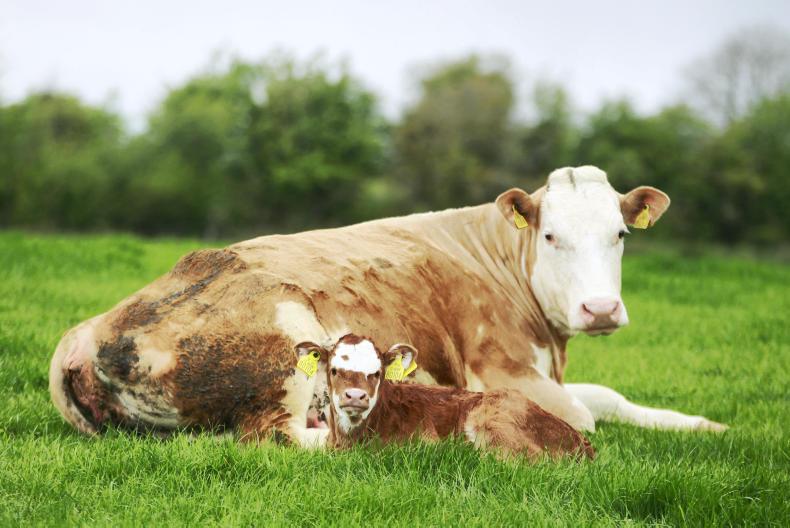Farmers attending last week’s Irish Grassland Association beef conference heard presentations from the Irish Farmers Journal, Teagasc and Bord Bia. We take a look at some of the key messages from the event
Efficiency pays €455/cow – Ciarán Lenehan
Making efficiency changes within the farm gate can deliver the equivalent of a €1.20kg increase in beef price on a typical 50-cow suckler to beef herd. “Controlling what is within your control” was Irish Farmers Journal livestock specialist Ciarán Lenehan’s key message and, while he maintained that lobbying for higher beef prices was also important, farmers had little control on world beef markets at the end of the day. Lenehan outlined how calving home-bred replacements at 24 months v 36 months could deliver €4,400 to a typical 50 suckler cow herd. Reducing a suckler herd’s calving interval from 399 days to the target 365 days represents a €75/cow income potential. That is €2.20/day for every day a cow slips over 365 days. Reducing calf mortality from 6.4% to 4% could deliver a potential €21/cow. Achieving target weight gains in a beef herd can have a huge impact on profitability. Increasing liveweight gain and in turn weaning weights will have a huge impact on profitability. In a spring-calving system, selling weanlings, an extra 0.15kg/day in weight gain could deliver an extra €90/cow or €4,500 in a typical 50-cow herd.
Maintaining access to 65m affluent consumers – Joe Burke
Joe Burke, beef and livestock sector manager with Bord Bia, outlined the challenges that lie ahead in terms of Brexit and the potential impact that it may have. Ireland’s total food and drink export to the UK is valued at €4.13bn, with the beef sector being the major focus when it comes to the UK market, with 50% of Irish beef exports.
This accounted for 270,000t of beef valued at €1.1bn. This means that the beef sector is exposed to any possible trade implications with Britain exiting the EU. By comparison, just 25% of dairy products are sent to the UK. To put the reputation that Irish beef has in the UK in context, Ireland is the only imported beef supplier to the three largest UK retailers: Tesco, Asda and Sainsbury’s as well as to McDonald’s and Burger King. Burke said: “Many British consumers consider Irish beef as being British when it comes to meat purchases”. At retail level, buyers will only accept product which has been processed within eight days of slaughter and has never been frozen. This is particularly important because mince now accounts for almost 50% of the volume of beef sold to UK supermarkets and means that Irish beef cannot be easily displaced by imports from further afield.
The worst possible outcome would be a hard Brexit where Britain would revert to WTO rules and apply trade tariffs on imported product. At current levels, these tariffs would have a very damaging impact on the Irish beef trade with boneless cuts carrying a tariff or over €3.00 plus 12.8% of value and a rate of €1.76/kg applied to carcases. Burke finished up by saying that a positive outcome from Brexit from an Irish beef perspective would be one that maintains preferential access to the UK market and allows any alterations to trade be phased in over a long transition period.
Terminal index delivers €200/hd on Kildare farms – Christy Watson
Christy Watson, Teagasc adviser, Naas, outlined some interesting analysis of a large finisher client which purchases store cattle and bring them to slaughter. With over 65% of cattle born in Ireland to a beef sire traded, it’s very important that the finisher concentrates on the most profitable animals available to them. While there has been lots of talk around the replacement index, there is little talk about the terminal index of animals, which is more important in finishing systems. An animal with a terminal index of €150 is expected to leave a extra €100 in profit over an animal with an index of €100. So does it work? Watson looked at a herd which finishes over 400 animals annually. He found that the 4/5 star animals were 43kg heavier at slaughter than the 1/2 star animals. He also showed how the 4/5 stars were slaughtered 22 days earlier which represented a big saving in feed costs. Carcase value for the 1/ 2 star animals was €1,506, while it was €1,650 for the 4/5 star animals, a difference of €144 per animal. When feed costs are included, the difference comes close to €200/head in favour of 4/5 star terminal animals. Watson finished by encouraging the industry to use the science that is available and start displaying the terminal index at point of purchase.
Huge potential for grass on beef farms – Mike Egan
Irish beef farms have an important competitive advantage in producing beef over many of their European counterparts due to the ability to grow and utilise high quantities of grazed grass.
The cost of producing 1kg of liveweight gain in Ireland from grass is 80-85% less when compared with an intensive concentrate-based system. One tonne of increased grass growth per hectare is worth €105/ha to beef farmers.
The average drystock farm in Ireland utilises 5.4t/DM/ha with scope to increase this to 12-14 t/DM/ha on very efficient farms. Soil fertility, grazing infrastructure and better grazing management are all areas which need improvement if Irish beef farms are to fully capitalise on grass. Farms that concentrate on output from grass-based systems through improved management and performance will increase profits irrespective of beef price.
Egan said: “There are only one in 500 beef farms currently measuring grass on PastureBase Ireland. It has been shown in recent years that farmers who measure will grow and utilise more grass so it’s a change that needs to take place.”






 This is a subscriber-only article
This is a subscriber-only article










SHARING OPTIONS: